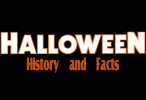
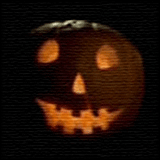 Halloween's theme is spooky or scary things particularly involving death,
magic, or mythical monsters. Commonly-associated Halloween characters include
ghosts, ghouls, witches, bats, black cats, owls, spiders, goblins, zombies,
skeletons and demons, as well as certain fictional figures like Dracula
and Frankenstein's monster. Homes are often decorated with these symbols
around Halloween.
Halloween's theme is spooky or scary things particularly involving death,
magic, or mythical monsters. Commonly-associated Halloween characters include
ghosts, ghouls, witches, bats, black cats, owls, spiders, goblins, zombies,
skeletons and demons, as well as certain fictional figures like Dracula
and Frankenstein's monster. Homes are often decorated with these symbols
around Halloween.
Black and orange are the traditional colors of Halloween. In modern Halloween images and products, purple, green, and red are also prominent. Elements of the autumn season, such as pumpkins and scarecrows, are also reflected in symbols of Halloween. The jack-o'-lantern, a carved vegetable lit by a candle inside, is one of Halloween's most prominent symbols. In Britain and Ireland, a turnip was and sometimes still is used, but immigrants to America quickly adopted the pumpkin because it was more readily available; additionally, it is much larger and easier to carve. Many families that celebrate Halloween carve a pumpkin into a frightening or comical face and place it on their home's doorstep after dark. The practice was originally intended to frighten away evil spirits or monsters.
In Ireland, great bonfires were lit throughout the breadth of the land. Young children in their guises were gladly received by the neighbors with some 'fruit, apples and nuts' for the 'Halloween Party', whilst older male siblings played innocent pranks on bewildered victims. 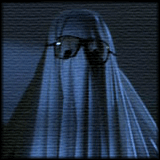 In Scotland, children or guisers are more likely to recite "The
sky is blue, the grass is green, may we have our Hallowe'en" instead of
"trick or treat!". They visit neighbours in groups and must impress the
members of the houses they visit with a song, poem, trick, joke or dance
in order to earn their treats. Traditionally, nuts, oranges, apples and
dried fruit were offered, though sometimes children would also earn a small
amount of cash, usually a sixpence. Very small children often take part,
for whom the experience of performing can be more terrifying than the ghosts
outside.
In Scotland, children or guisers are more likely to recite "The
sky is blue, the grass is green, may we have our Hallowe'en" instead of
"trick or treat!". They visit neighbours in groups and must impress the
members of the houses they visit with a song, poem, trick, joke or dance
in order to earn their treats. Traditionally, nuts, oranges, apples and
dried fruit were offered, though sometimes children would also earn a small
amount of cash, usually a sixpence. Very small children often take part,
for whom the experience of performing can be more terrifying than the ghosts
outside.
Tricks play less of a role in modern Halloween, though Halloween night is often marked by vandalism such as soaping windows, egging houses or stringing toilet paper through trees. Before indoor plumbing was so widespread, tipping over or displacing outhouses was a popular form of intimidation. Casting flour into the faces of feared neighbors was also done once upon a time. Typical Halloween costumes have traditionally been monsters such as vampires, ghosts, witches, and devils. In 19th-century Scotland and Ireland the reason for wearing such fearsome (and non-fearsome) costumes was the belief that since the spirits that were abroad that night were essentially intent on doing harm, the best way to avoid this was to fool the spirits into believing that you were one of them. In recent years, it has become common for costumes to be based on themes other than traditional horror, such as dressing up as a character from a TV show or movie, or choosing a recognizable face from the public sphere, such as a politician (in 2004, for example, George W. Bush and John F. Kerry were both popular costumes in America). In 2001, after the September 11 attacks, for example, costumes of firefighters, police officers, and United States military personnel became popular among children. In 2004, an estimated 2.15 million children in the United States were expected to dress up as Spider-Man, the year's most popular costume. "'Trick-or-Treat for UNICEF" has become a common sight during Halloween in North America. Started by UNICEF in 1950, the program involves the distribution of small boxes by schools to trick-or-treaters, in which they can solicit small change donations from the houses they visit. It is estimated that children have collected more than $119 million for UNICEF since its inception. BIGresearch conducted a survey for the National Retail Federation in the US and found that 53.3% of consumers planned to buy a costume for Halloween 2005, spending $38.11 on average (up 10 dollars from last year). An estimate of $3.3 billion was made for the holiday spending. A child usually "grows out of" trick-or-treating by his or her teenage years. Trick-or-treating by teenagers is accepted, but generally discouraged with genial ribbing by those handing out candy. Teenagers and adults instead often celebrate Halloween with costume parties, staying home to give out candy, listening to Halloween music, or scaring people. Visiting a Haunted house or a Dark Attraction are other Halloween traditions. Notwithstanding the name, such events are not necessarily held in houses, nor are the edifices themselves necessarily regarded to possess actual ghosts. A variant of this is the haunted trail, where the public encounters supernatural-themed characters or presentations of scenes from horror films while following a trail through a heavily wooded area or field.
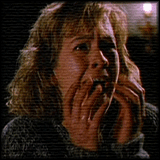 Some games traditionally played at Halloween are forms of divination.
In Puicíní (pronounced "pooch-eeny"), a game played in Ireland,
a blindfolded person is seated in front of a table on which several saucers
are placed. The saucers are shuffled and the seated person then chooses
one by touch. The contents of the saucer determine the person's life for
the following year. A saucer containing earth means someone known to the
player will die during the next year, a saucer containing water foretells
travel, a coin means new wealth, a bean means poverty, etc. In 19th-century
Ireland, young women placed slugs in saucers sprinkled with flour. The
wriggling of the slugs and the patterns subsequently left behind on the
saucers were believed to portray the faces of the women's future spouses.
Some games traditionally played at Halloween are forms of divination.
In Puicíní (pronounced "pooch-eeny"), a game played in Ireland,
a blindfolded person is seated in front of a table on which several saucers
are placed. The saucers are shuffled and the seated person then chooses
one by touch. The contents of the saucer determine the person's life for
the following year. A saucer containing earth means someone known to the
player will die during the next year, a saucer containing water foretells
travel, a coin means new wealth, a bean means poverty, etc. In 19th-century
Ireland, young women placed slugs in saucers sprinkled with flour. The
wriggling of the slugs and the patterns subsequently left behind on the
saucers were believed to portray the faces of the women's future spouses.
In North America, unmarried women were frequently told that if they sat in a darkened room and gazed into a mirror on Halloween night, the face of their future husband would appear in the mirror. However, if they were destined to die before they married, a skull would appear. The custom was widespread enough to be commemorated on greeting cards from the late nineteenth century. The telling of ghost stories and viewing of horror films are common fixtures of Halloween parties. Television specials with a Halloween theme, usually aimed at children, are commonly aired on or before the holiday while new horror films are often released theatrically before the holiday to take advantage of the atmosphere.
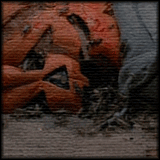 Because the holiday comes in the wake of the annual apple harvest,
Candy Apples (also known as toffee, taffy or caramel apples) are a common
treat at Halloween. They are made by rolling whole apples in a sticky sugar
syrup, and sometimes then rolling them in nuts. At one time candy apples
were a common treat given to children, but this practice rapidly waned
after widespread rumors that some individuals were embedding items like
pins and razor blades in the apples that they would pass out to children.
While there is evidence of such incidents occurring they are very rare
and have never resulted in any serious injuries. Nonetheless, many parents
were under the assumption that the practice was common. At the peak of
this hysteria, some hospitals were offering to x-ray children's Halloween
haul at no cost in order to look for such items. Almost all of the very
few Halloween candy poisoning (as opposed to tainting) incidents on record
involved parents who poisoned their own children's candy, while there are
occasional reports of kids sticking needles in their own candy (and that
of other children) more in an effort to get attention than cause any harm.
Yet the paranoia has continued unabated mostly because of the news media's
misinformation and tendency to exaggerate threats — especially when children
are involved.
Because the holiday comes in the wake of the annual apple harvest,
Candy Apples (also known as toffee, taffy or caramel apples) are a common
treat at Halloween. They are made by rolling whole apples in a sticky sugar
syrup, and sometimes then rolling them in nuts. At one time candy apples
were a common treat given to children, but this practice rapidly waned
after widespread rumors that some individuals were embedding items like
pins and razor blades in the apples that they would pass out to children.
While there is evidence of such incidents occurring they are very rare
and have never resulted in any serious injuries. Nonetheless, many parents
were under the assumption that the practice was common. At the peak of
this hysteria, some hospitals were offering to x-ray children's Halloween
haul at no cost in order to look for such items. Almost all of the very
few Halloween candy poisoning (as opposed to tainting) incidents on record
involved parents who poisoned their own children's candy, while there are
occasional reports of kids sticking needles in their own candy (and that
of other children) more in an effort to get attention than cause any harm.
Yet the paranoia has continued unabated mostly because of the news media's
misinformation and tendency to exaggerate threats — especially when children
are involved.
A Halloween custom which has survived unchanged to this day in Ireland is the baking (or more often nowadays the purchase) of a barmbrack (Irish "báirín breac"). This is a light fruit cake into which a plain ring is placed before baking. It is said that whoever finds this ring will find his or her true love during the following year.
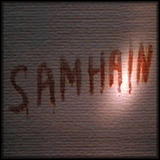 As November 1 is the first day of the new year, the day also meant
the beginning of Winter, which the Celts often associated with human death.
The Celts also believed that on October 31 (the night before the new year),
the boundary separating the dead from the living became blurred. (There
is a rich and unusual myth system at work here; the spirit world, the residence
of the "Sidhe," as well as of the dead, was accessible through burial mounds.
These mounds opened at two times during the year, making the beginning
and end of Summer highly spiritually resonant.)
As November 1 is the first day of the new year, the day also meant
the beginning of Winter, which the Celts often associated with human death.
The Celts also believed that on October 31 (the night before the new year),
the boundary separating the dead from the living became blurred. (There
is a rich and unusual myth system at work here; the spirit world, the residence
of the "Sidhe," as well as of the dead, was accessible through burial mounds.
These mounds opened at two times during the year, making the beginning
and end of Summer highly spiritually resonant.)
The Celts' survival during the cold harsh winters, depended on the prophecies of their priests or Druids. They believed that the presence of spirits would aid in the priests' abilities to make future predictions. The exact customs observed in each Celtic region differ, but they generally involved the lighting of bonfires and the reinforcement of boundaries, across which malicious spirits might cross and threaten the community. Like most observances around this season, warmth and comfort were emphasized, indulgence was not. Stores of preserved food were needed to last through the winter, not for parties.
Copyright ©
Wikipedia / TheFleshFarm.com
|

